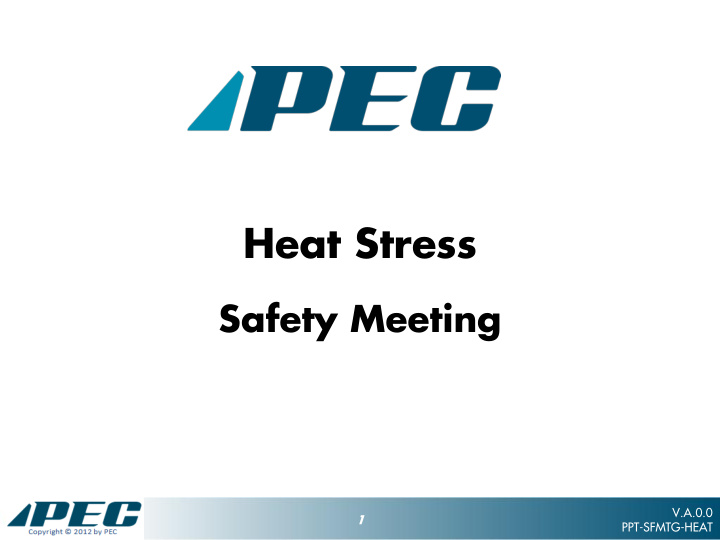



Heat Stress Safety Meeting V.A.0.0 1 1 PPT-SFMTG-HEAT
Sources of Heat • High temperature or humidity • Limited air movement • Direct sun exposure • Indoor exposure to radiant heat sources • Low fluid consumption • Physical exertion V.A.0.0 2 2 PPT-SFMTG-HEAT
Hot Weather Work V.A.0.0 3 3 PPT-SFMTG-HEAT
Risk Factors • Seldom work outdoors or in heat • Not physically fit or are overweight • Drinking alcohol or taking drugs • Wearing heavy, dark or tight fitting clothing or use of certain PPE • Having any prior heat related symptoms V.A.0.0 4 4 PPT-SFMTG-HEAT
Types of Heat • Heat stroke • Heat exhaustion • Heat cramps • Heat rash • Fainting V.A.0.0 5 5 PPT-SFMTG-HEAT
Heat Stroke • Most serious form of heat stress • Body becomes unable to control its temperature • Body temperature rises rapidly • Sweating mechanism fails • Body is unable to cool down • Medical emergency V.A.0.0 6 6 PPT-SFMTG-HEAT
Heat Stroke Symptoms • Hot, dry skin or profuse sweating • Hallucinations • Chills • Headache • Confusion/dizziness • Very high body temperature • Slurred speech V.A.0.0 7 7 PPT-SFMTG-HEAT
Heat Exhaustion • Body's response to excessive loss of water and salt through sweating • Extreme weakness or fatigue, giddiness, nausea or headaches • Usually recover naturally with proper treatment V.A.0.0 8 8 PPT-SFMTG-HEAT
Heat Exhaustion Symptoms • Heavy sweating • Elevated body temperature • Headache • Nausea, dizziness or weakness • Irritability • Fast and shallow breathing • Pale or flushed complexion • Muscle cramps V.A.0.0 9 9 PPT-SFMTG-HEAT
Heat Cramps • Muscle pains usually caused by physical labor or strenuous activity • Sweating depletes body's water content and salt level • Low salt levels in muscles cause painful cramps − Can occur during or after work V.A.0.0 10 10 PPT-SFMTG-HEAT
Heat Cramp Symptoms • Muscle pain • Spasms • Symptoms usually occur to the abdomen, arms or legs V.A.0.0 11 11 PPT-SFMTG-HEAT
Heat Rash • Skin irritation caused by sweating • Sweat does not evaporate and skin remains wet • Sweat ducts become plugged and a rash may appear • Also known as prickly heat V.A.0.0 12 12 PPT-SFMTG-HEAT
Heat Rash Symptoms • Red cluster of pimples or small blisters on the skin • Usually appears on the neck, upper chest, groin and inside elbow creases V.A.0.0 13 13 PPT-SFMTG-HEAT
Fainting • Dizziness that usually occurs with − Prolonged standing − Sudden rising from a sitting or lying position • Caused by dehydration V.A.0.0 14 14 PPT-SFMTG-HEAT
Fainting Symptoms • Light headedness • Dizziness • Faded hearing or ringing in the ears • Darkened or blurred vision • Paleness • Shortness of breath V.A.0.0 15 15 PPT-SFMTG-HEAT
First Aid Response for Heat Stress • Notify the supervisor • Get medical help • Move to a cooler place or into the shade − Do not leave a coworker alone − Be prepared to describe symptoms • Drink water • Loosen clothing • Stay cool V.A.0.0 16 16 PPT-SFMTG-HEAT
Heat Stress Prevention • Water • Rest • Shade • Report heat symptoms • Training • Emergency plan V.A.0.0 17 17 PPT-SFMTG-HEAT
V.A.0.0 18 18 PPT-SFMTG-HEAT
Heat Stress Prevention • Add more frequent breaks during a heat wave • Schedule strenuous work during cooler times of the day V.A.0.0 19 19 PPT-SFMTG-HEAT
Heat Stress Prevention • Employers − Provide training on hazards and prevention − Provide cool water close to the work area − Schedule frequent rest periods in shade − Schedule strenuous work during cooler times of the day − Routinely check workers who are at risk − Consider PPE that provides cooling V.A.0.0 20 20 PPT-SFMTG-HEAT
Heat Stress Prevention • Worker − Know the signs and symptoms − Block direct sun and other heat sources − Drink small amounts frequently, as opposed to larger amounts less often − Drink even if you do not feel thirsty − Avoid caffeinated or alcoholic beverages − Drink plenty of water before, during and after work to help your body recover V.A.0.0 21 21 PPT-SFMTG-HEAT
Recommend
More recommend